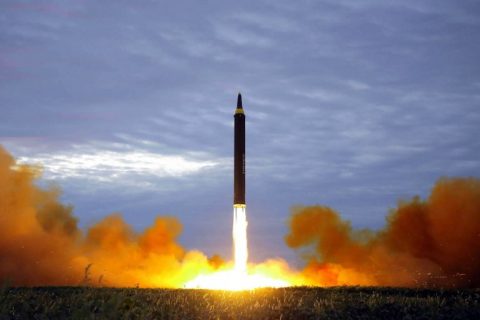

by Shingo Ito
Agence France Presse
TOKYO, Japan (AFP) — When nuclear-armed North Korea fired a ballistic missile over Japan this week, it sparked international condemnation. But it also raised the question: Why Japan?
Location
It might seem obvious, but geography is frequently a huge factor in geopolitical wrangling.
The Japanese archipelago forms a long string off the coast of mainland north Asia, so by definition, any regional player that wants to fire a medium- or long-range missile into the Pacific has to go over it.
Tuesday’s projectile travelled around 2,700 kilometers (1,700 miles) from its launch site near Pyongyang before crashing into the ocean, around 1,200 kilometers off Japan’s northern Hokkaido island.
Having threatened a few weeks ago to fire missiles towards the US Pacific territory of Guam — around 3,500 kilometers away — the range could have been selected to remind Washington that Pyongyang has the capacity to follow through.
But unlike cashing that cheque and risking conflict with the world’s top military power, firing missiles over pacifist Japan was not likely to provoke an armed response.
So, Tuesday’s launch let Pyongyang rattle a major US ally, which hosts American military bases and tens of thousands of US troops, while showing it has the ability to strike Guam if it wants to.
“It is also sending a message that Japan is well within its sights if a war breaks out,” Professor Koh Yu-Hwan at Dongguk University told AFP.
Rocky relations
North Korea hinted at another reason Japan was in its sights: history.
The missile, it said Wednesday, was timed to mark the 107th anniversary of the “disgraceful” Japan-Korea treaty of 1910, under which Tokyo colonized the Korean peninsula.
The North’s official KCNA news service said leader Kim Jong-Un “gave vent to the long-pent grudge of the Korean people” with “a bold plan to make the cruel Japanese islanders insensible on bloody August 29”.
Japan’s colonization of a then-unified Korea ushered in a period of oppressive rule that only ended with Tokyo’s defeat in WWII.
The Imperial army forced thousands of Korean women to work as sex slaves in military brothels during the war, a practice that weighs heavily on ties with both Koreas today.
Tokyo-Pyongyang relations have also been strained over the kidnapping of Japanese citizens during the 1970s and 1980s to train North Korean spies.
What can Japan do?
Japan has pretty much exhausted its diplomatic options.
Most of the world condemns North Korea’s missile and nuclear weapons development and, like the US, Tokyo has already imposed sanctions against Pyongyang, widening them as recently as last week.
Japan’s Prime Minister Shinzo Abe will call for ratcheting up pressure on Pyongyang — probably more sanctions — when he attends next month’s UN general assembly. Few experts think that will produce any meaningful change.
Domestically, the launch gives Japan a reason to beef up its missile defense system, including adopting a land-based Aegis missile defense scheme to complement its sea-based system, and will likely boost calls for an early warning satellite system.
It could also reignite debate over Japan’s own nuclear deterrence, especially if the North conducts another atomic test. But that is a touchy subject given Japan’s history as the only nation ever to have been attacked by nuclear weapons.
Why didn’t Japan shoot the missile down?
Japan says it didn’t blow the missile out of the sky because it was not a threat to its territory and flew above its airspace — although Tokyo warned millions of Japanese to take cover.
But some experts suspect Japan’s missile defense may have a maximum height range of around 500 kilometers (3s0 miles). If correct, that means it may not have been capable of destroying Tuesday’s rocket, which reached an altitude of 550 kilometers.
“As far as our capacity is concerned, discussing it would mean showing our hand,” Japan’s Defense Minister Itsunori Onodera said Tuesday.
“But let me assure you that we’re capable of taking the necessary actions,” he added.
Another consideration could have been North Korea’s response to any such downing.
Although many in the international community would have seen it as a legitimate — and limited — act of self-defense, Japan’s erratic neighbor might have considered it an act of aggression.
And in the tinderbox of northeast Asia, things could quickly have got out of hand.
Agence France-Presse
